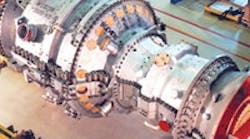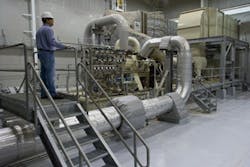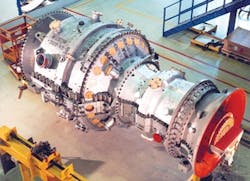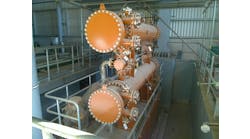- buy a compressor package to maximize fabrication and set-up work done in the vendor’s shop (Figure 2);
- simplify the package’s transportation and installation;
- opt for modularized components that are easy to change;
- reduce onsite personnel requirements and encourage unmanned operation; and
- eliminate standby compressors to the fullest extent possible.
Estimating the installation cost of the new compressor can be tough. Compressor size and capacity as well as the plant’s nature and location significantly impact the cost. Unfortunately, only limited literature on compressor cost estimation is available. So, here, let’s go over some general pointers.
Figure 1. Compressors play a crucial role at many chemical plants. Source: Spectra Energy.
First, the cost of a compressor is roughly: U.S. $0.5–0.9 million/MW for the 5–15 MW range; $0.8–1.5 million/MW for the 1–5 MW range; and $1.3–4/W for units below 1 MW.
Studies on recent compressor installations indicate:
• The civil works (site development, foundations, etc.) account for around 9–14% of the total cost.
• Installation runs approximately 7–11% of the total cost.
The time required for installing and commissioning a compressor can vary significantly. The following ranges are typical for packaged compressors: large packages (3–20 MW), 1,000–2,000 hours; and small packages (<2 MW), 200–800 hours.
INSTALLATION COST ESTIMATE
You can accurately estimate some costs, notably that of the compressor package (from the vendor proposal) and those of materials (as detailed by suppliers). However, other estimates are relatively inaccurate. Labor costs have much larger overruns compared to other cost components.
Historical data allow developing models capable of estimating installation cost within certain limits, via:
Compressor Unit Cost = A × (Compressor Package Cost) + B
Figure 2. Shop fabrication and set-up can reduce installation cost. Source: Siemens.
Factor A relates to all auxiliaries and accessories required for each compressor package, such as the foundation, civil works, piping, additional steel structures, etc.; its value usually falls between 1.25 and 2.5. The “Compressor Package Cost” includes all skid-mounted facilities, such as the driver, cooler(s), lubrication oil system et al. Factor B represents all auxiliaries and accessories required for each compressor unit, such as unit piping, unit utilities, protection systems, unit pit/drain, unit electrical facilities, safety equipment, firefighting facilities, unit steel structures, unit civil works, etc. Because errors due to underestimating the cost of components and services generally are larger than those due to overestimating, always include proper safety margins on A and B.
Various cost studies indicate a large difference in compressor unit cost among regions, with areas having established installation infrastructure and skilled personnel notably less costly. Studies also show that, because large compressors offer economies of scale and low unit cost, compressor installation costs decrease with increasing compressor size. So, it’s important to develop a proper set of factors for a defined range of compressor unit sizes and capacities for a region.
In addition, the cost estimate should take into account, as appropriate, environmental conditions, the nature of the soil and terrain, cost of living, population density, noise limits, applicable codes and distance from compressor supplies.
CASE STUDIES
First, let’s evaluate a 9-MW compressor unit. I obtained the following costs for electric-motor-driven compressor packages:
• 9 MW: U.S. $5.4 million (around $0.6 million/MW);
• 4.5 MW: U.S. $3.8 million (around $0.84 million/MW); and
• 2.3 MW: U.S. $2.7 million (around $1.17 million/MW).
I reckon factor A to be 1.46 for these packages and factor B to be around $2.5 million for a 9-MW compressor unit. Table 1 compares the cost of these options. It shows that use of smaller compressors will increase cost considerably.
Now, let’s look at two options for a small compressor installation:
• 40 kW: U.S. $105,000 (around $2.6/W); and
• 25 kW: U.S. $85,000 (around $3.4/W).
For these small packages, I estimate A to be 1.31 and B to be around $77,000 for option 1 and $66,500 for option 2. Table 2 shows the cost analysis. It indicates that opting for the 25-kW compressor, which is 38% smaller than the 40-kW one, only leads to an expected 17% reduction in total installed cost.
AMIN ALMASI is a rotating equipment consultant based in Brisbane, Australia. E-mail him at [email protected].





